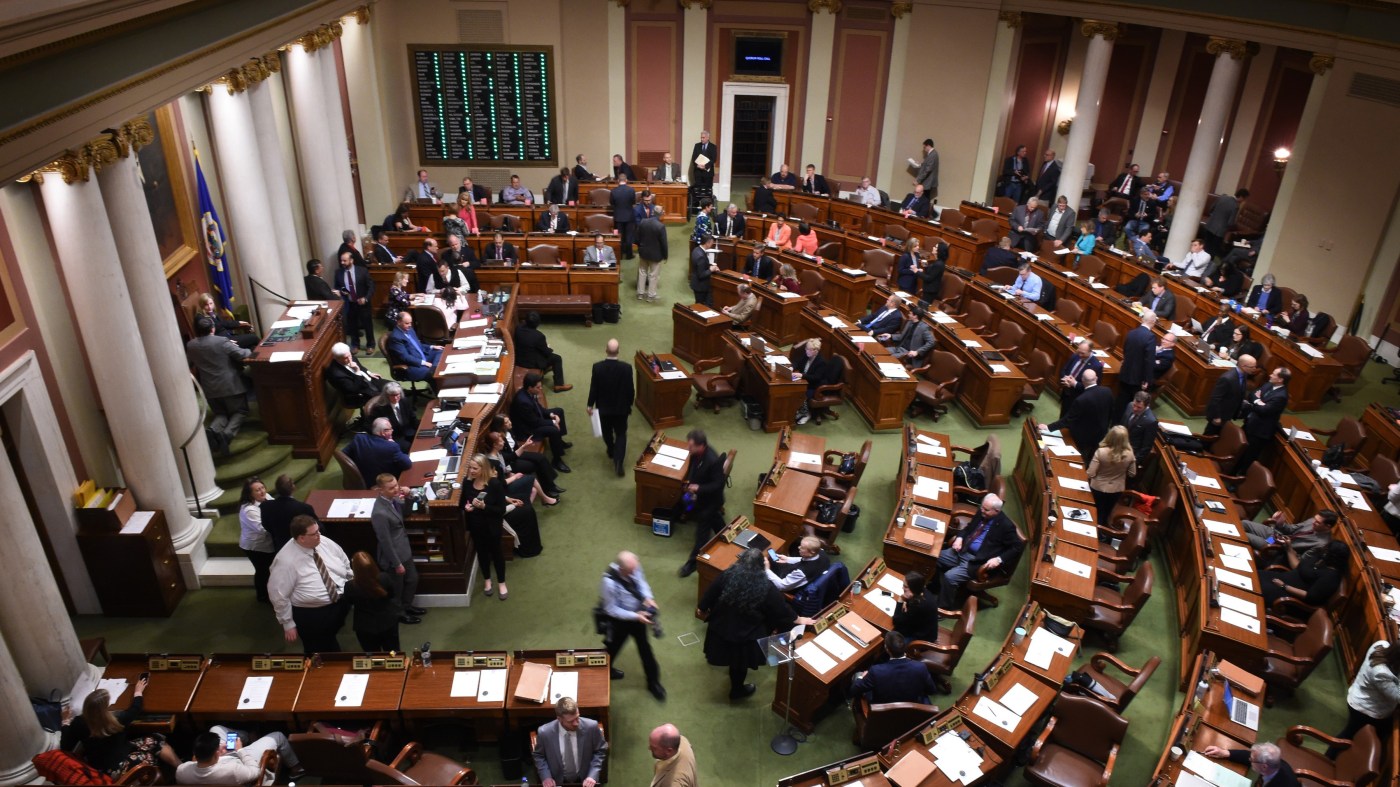
DFL control of Minnesota government hinges on state House elections. A handful of districts will be key.
When Minnesotans go to the polls this fall, they won’t just vote for president and U.S. Senate. They’ll also decide whether the Democratic-Farmer-Labor Party should have another two years of control over state government.
All 134 of the seats in the Minnesota House of Representatives are up for election this year, and if Republicans gain a handful, Democrats, who control the Senate, House and governor’s office, will no longer be able to pursue their agenda with minimal resistance as they have these past two years.
Who comes out on top likely will depend on elections in a little more than a dozen key House districts — and just maybe a state Senate seat in the west metro, where there’s a special election to fill the seat of Sen. Kelly Morrison, DFL-Deephaven, who left office to run for Congress. With Morrison gone, the Senate is currently split 33-33.
In the most recent legislative session, the DFL held a 70-64 majority over Republicans in the Minnesota House. After recent retirements, the balance is 68-63. If the GOP wants to wrest control, they’ll have to reach a minimum of 68 seats.
The contest for the House will center around districts in the Twin Cities metro suburbs, northeast Minnesota’s Iron Range, and in a few rural regional centers. Leaders in both parties recognize those districts as key to winning and are mobilizing their resources accordingly.
A national Democratic group, the Democratic Legislative Campaign Committee, this month announced it would be focusing on 13 races across Minnesota. Meanwhile, a similar national group, the Republican State Leadership Committee, says it plans to invest in Minnesota races as well.
What’s at stake?
There’s a lot of focus at the top of the ballot with the presidential election, especially with Minnesota Gov. Tim Walz running with Democratic presidential nominee Vice President Kamala Harris. But the result of the state House elections will affect how the state shapes its budget next year and comes after historic wins for Democrats.
After the DFL won control of the Minnesota Legislature and held onto the governor’s office in 2022, they enacted a significant number of bills previously impossible under a government divided with Republicans.
In the 2023 session, DFLers put strong abortion rights protections in state law, created a paid family and medical leave program, enacted universal free school meals, made public college free for families earning less than $80,000 a year and legalized recreational marijuana.
They also used most of the historic $17.5 billion budget surplus and increased government spending by nearly 40% over the next two years to pay for new programs and boost funding for other areas, like education and child tax credits.
Republicans say the state should have used the surplus for tax cuts and bigger rebates to taxpayers, but Democrats are more than happy to campaign on their record in the upcoming election.
Undated courtesy photo, circa September 2022, of House Speaker Melissa Hortman of Brooklyn Park, candidate for re-election to House District 34B in the November 2022 election. (Courtesy of the candidate)
“Democrats and Republicans both would have spent the entire $17.5 billion. The difference is we gave it to ordinary Minnesotans,” said House Speaker Melissa Hortman, DFL-Brooklyn Park, “We put the money in people who go to work for a living.”
Hortman said Democrats will not pursue the same sweeping agenda they did during the 2023 session if they keep control of state government. Earlier this year at the end of the last legislative session, she said next year’s focus would be working on affordable health care and addressing funding gaps left by the expiration of federal pandemic aid.
House Republicans are campaigning to bring what they call balance in state government. They’re hoping voters will see spending increases as unsustainable and reject new taxes and fees DFLers enacted last year, like the new payroll tax for the paid leave program, metro-area sales tax hikes, and vehicle registration fees.
Republicans say DFLers created $10 billion in new taxes in 2023.
“Not only was the surplus not invested in a meaningful and ongoing way, but yet that wasn’t enough,” said House Republican Minority Leader Lisa Demuth, R-Cold Spring. “So Democrats in the state of Minnesota raised the state budget.”
House Minority Leader Lisa Demuth. (Courtesy photo)
Amy Koch, a former Republican Senate majority leader, said she sees the race for the House being a close one, potentially yielding a 68-66 two-seat majority in either direction. If Republicans want to end the DFL government trifecta, she said, they’ll have to focus on an economic message and get through the new national aspect of the race brought on by Walz.
“Republicans have to make the case that there are problems with the things they passed,” she said. “It’s going to be hard to break through that noise, and that’s what they’ve got to do on a very local level, which means a lot of local, door-to-door politics.”
Top ticket trickle-down?
This election year will be unique as Minnesota’s governor is at the top of the ballot as a presidential candidate’s running mate. And another successful Democrat is running as well — U.S. Sen. Amy Klobuchar is running for her fourth term.
Hortman said she thinks that’ll give Democrats a boost this fall, though they won’t be taking that advantage for granted and will also be focusing on a door-to-door economic message with constituents.
Republicans see Walz’s top-of-the-ticket status as a new opportunity to discuss the spending he approved in 2023, and other issues that have come up while he was governor.
“I think that national voice on the record of what Gov. Walz has signed into law and some of the concerns that go along with it, that is only helping our case,” Demuth said. “He could only sign into law or allow what has happened in some of these concerning areas, because House Democrats voted for all of it.”
Most of the 134 house seats up for election are not considered competitive by both DFL and Republican political strategists, and control of the chamber likely will come down to a handful of races.
Of the 16 districts deemed competitive, some have seen close races in the past and others have seen incumbents retire — sometimes leaving behind an open seat in a district that has shifted toward the other party.
Suburban races
Some of the closest races likely will be in the Twin Cities suburbs. Two Washington County representatives — Rep. Mark Wiens, R-Lake Elmo, and Rep. Shane Hudella, R-Hastings, who are not running for reelection, won by hundreds of votes in 2022. The contests for their seats are seen as competitive.
Rep. Elliott Engen, a first-term Republican whose district covers Lino Lakes, North Oaks and White Bear Township who won by 2 percentage points in 2022, faces a challenger backed by a national Democratic group.
DFL Reps. Zack Stephenson of Coon Rapids and Brad Tabke of Shakopee are defending seats of interest to both parties. In another district covering Coon Rapids, DFLer Kari Rehrauer is running against Republican Steve Pape to replace DFL Rep. Jerry Newton.
Reps. Matt Norris, DFL-Blaine, Lucy Rehm, DFL-Chanhassen, and Jeff Witte, R-Lakeville, also are defending seats in races seen as competitive.
Rural races
Two rural Minnesota districts currently held by DFLers that could flip to the GOP are an Iron Range district held by outgoing Rep. Dave Lislegard, DFL-Aurora, and a southeastern Minnesota district held by now-retired Rep. Gene Pelowski of Winona.
The Democratic Legislative Campaign Committee did not mention either race in a recent news release highlighting where the group planned to spend money.
There are other Republican-held districts in northern Minnesota that Democrats hope to flip. One is a rural Duluth-area district held by Republican Rep. Natalie Zeleznikar, who ousted four-decade Rep. Mary Murphy by 33 votes two years ago.
Another district covers the Arrowhead region, which former Ely Mayor Roger Skraba won in 2022. Skraba beat four-term Rep. Rob Ecklund, DFL-International Falls, by just 15 votes. Democrats hope they can take the seat back.
There are also competitive races in the St. Cloud area in districts held by Rep. Dan Wolgamott, DFL-St. Cloud, and Rep. Bernie Perryman, R-St. Augusta.
Rep. Jeff Brand, DFL-St. Peter, is also defending his seat in a race seen as competitive.
Related Articles
Minnesotans to vote on whether lottery money will continue funding conservation, environment
Tyler Cowen: Maybe legalizing weed wasn’t such a great idea
The race that may determine control of the MN Senate, other east metro primary election results of note
Perennial candidate Sharon Anderson wins GOP primary for House 67B seat on St. Paul’s East Side
Minnesota House candidate, wife charged over stolen campaign signs; DFL committee rescinds endorsement


